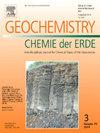New bulk rock and age data on the changes in magma evolution during the Miocene, Galatean volcanic area, central Anatolia, Turkey: A review
IF 2.9
3区 地球科学
Q2 GEOCHEMISTRY & GEOPHYSICS
引用次数: 0
Abstract
The Galatean Volcanic Province (GVP) lies within the Sakarya tectonic belt in the northwest of central Anatolia, Turkey, south of the North Anatolian Fault, cropping out over 12,000 km2. It consists of Early Miocene intermediate to acid lavas, pyroclastic rocks, volcaniclastic deposits, and Late Miocene OIB-like basalts. Our study is based on new bulk geochemistry, Sr![]() Nd isotopes, and 40Ar/39Ar dating of the volcanic rocks from the south-western part of GVP, but integrates all the available previous data to understand how magmas evolved in the post-collisional geodynamic condition in the GVP. The initial eruptions were rhyolitic, as domes or pyroclastic deposits (Group 1) and basaltic lavas (Group 2) during the Early Miocene. Group 2 is also represented by large volumes of basaltic-andesitic, trachyandesite-dacite/trachydacite lava flows, small intrusions, and pyroclastic deposits as generated between 21 and 14 Ma. Relatively low 87Sr/86Sr ratios (0.705–0.706) of the early rhyolites (Group 1), similar to all the rocks from Group (2), suggest the generation of hybrid melts with variable contributions of mantle-derived and crustal material. The volcanic activity ends with OIB-like basalts (11–7 Ma) showing the lowest 87Sr/86Sr (∼0.703) suggesting an asthenospheric origin.
Nd isotopes, and 40Ar/39Ar dating of the volcanic rocks from the south-western part of GVP, but integrates all the available previous data to understand how magmas evolved in the post-collisional geodynamic condition in the GVP. The initial eruptions were rhyolitic, as domes or pyroclastic deposits (Group 1) and basaltic lavas (Group 2) during the Early Miocene. Group 2 is also represented by large volumes of basaltic-andesitic, trachyandesite-dacite/trachydacite lava flows, small intrusions, and pyroclastic deposits as generated between 21 and 14 Ma. Relatively low 87Sr/86Sr ratios (0.705–0.706) of the early rhyolites (Group 1), similar to all the rocks from Group (2), suggest the generation of hybrid melts with variable contributions of mantle-derived and crustal material. The volcanic activity ends with OIB-like basalts (11–7 Ma) showing the lowest 87Sr/86Sr (∼0.703) suggesting an asthenospheric origin.
The geodynamic model, based on post-Cyprian slab rollback, results in long-term (22–13 Ma) post-collisional delamination/drip processes that support magmatism. This magmatism is generated in the lithospheric mantle, with the formation of basaltic melts and acid hybrid melts showing variable contributions of mantle-derived and crustal materials in a complex trans-crustal magma plumbing system. Complex mixing of various intra-crustal magmas and fractional crystallization processes generated a huge volume of volcanic rocks. The Late Miocene small-volume OIB basalts were asthenospheric melts that during the late stage recorded localized decompression melting processes.
土耳其安纳托利亚中部加拉泰斯火山区中新世岩浆演化变化的新大块岩石和年龄资料综述
加拉泰火山省(GVP)位于土耳其安纳托利亚中部西北部,北安那托利亚断层以南的萨卡里亚构造带内,面积超过12000平方公里。由早中新世中-酸性熔岩、火山碎屑岩、火山碎屑沉积和晚中新世obb型玄武岩组成。我们的研究基于新的整体地球化学、SrNd同位素和GVP西南部火山岩的40Ar/39Ar定年,但整合了所有可用的先前数据,以了解GVP碰撞后地球动力学条件下岩浆的演化过程。在中新世早期,最初的喷发为流纹岩,形成穹丘或火山碎屑沉积(组1)和玄武岩熔岩(组2)。第2组也有大量的玄武岩-安山岩、粗安山岩-英安岩/粗安山岩熔岩流、小型侵入体和火山碎屑沉积,形成于21 ~ 14 Ma之间。早期流纹岩(第1组)87Sr/86Sr比值较低(0.705 ~ 0.706),与第2组的岩石相似,表明形成了混合熔体,幔源物质和地壳物质的贡献各不相同。火山活动结束于oib样玄武岩(11-7 Ma),显示最低的87Sr/86Sr(~ 0.703),表明软流圈起源。基于后塞浦路斯板块回滚的地球动力学模型导致了长期(22-13 Ma)的碰撞后分层/滴注过程,支持岩浆作用。该岩浆活动产生于岩石圈地幔,玄武岩熔体和酸性混合熔体的形成表明,在一个复杂的跨地壳岩浆管道系统中,幔源物质和地壳物质的贡献是可变的。各种地壳内部岩浆的复杂混合和分块结晶作用产生了大量的火山岩。晚中新世小体积OIB玄武岩为软流圈熔体,在后期记录了局部减压熔融过程。
本文章由计算机程序翻译,如有差异,请以英文原文为准。
求助全文
约1分钟内获得全文
求助全文
来源期刊

Chemie Der Erde-Geochemistry
地学-地球化学与地球物理
CiteScore
7.10
自引率
0.00%
发文量
40
审稿时长
3.0 months
期刊介绍:
GEOCHEMISTRY was founded as Chemie der Erde 1914 in Jena, and, hence, is one of the oldest journals for geochemistry-related topics.
GEOCHEMISTRY (formerly Chemie der Erde / Geochemistry) publishes original research papers, short communications, reviews of selected topics, and high-class invited review articles addressed at broad geosciences audience. Publications dealing with interdisciplinary questions are particularly welcome. Young scientists are especially encouraged to submit their work. Contributions will be published exclusively in English. The journal, through very personalized consultation and its worldwide distribution, offers entry into the world of international scientific communication, and promotes interdisciplinary discussion on chemical problems in a broad spectrum of geosciences.
The following topics are covered by the expertise of the members of the editorial board (see below):
-cosmochemistry, meteoritics-
igneous, metamorphic, and sedimentary petrology-
volcanology-
low & high temperature geochemistry-
experimental - theoretical - field related studies-
mineralogy - crystallography-
environmental geosciences-
archaeometry
 求助内容:
求助内容: 应助结果提醒方式:
应助结果提醒方式:


